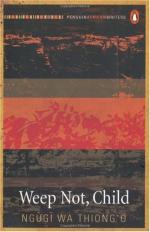|
This section contains 855 words (approx. 3 pages at 400 words per page) |

|
Point of View
Weep Not, Child uses a third person omniscient narrator to weave seamlessly through the perspectives of different characters, as well as providing objective descriptions of events and settings. As the book is written as an exploration of a society at a given point in time, this style of narration provides the reader with access to the histories and points of view of people on different sides of the political spectrum. For example, we are told about Mr Howlands' struggle to reconnect with his homeland upon his return from World War I from his perspective, and can then see a similar battle playing out within Boro. Similarly, Jacobo's statement to Njoroge that he will be needed to help rebuild the country echoes Njoroge's unexpressed belief in his own destiny as a savior.
In taking on the perspective of Njoroge or Mwihaki, who are children at the...
|
This section contains 855 words (approx. 3 pages at 400 words per page) |

|




